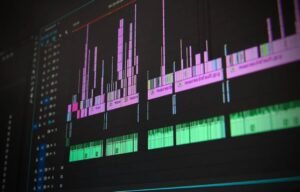Generative Literature
Generative literature is an emerging field that combines art, literature, and technology to create unique and ever-changing literary works. By using algorithms and computational techniques, generative literature challenges traditional notions of authorship and invites readers to actively participate in the creation and interpretation of texts.
Key Takeaways:
- Generative literature combines art, literature, and technology to create unique and ever-changing texts.
- Algorithms and computational techniques play a crucial role in the creation of generative literature.
- Generative literature challenges traditional notions of authorship and encourages reader participation.
Exploring the Boundaries of Authorship
In generative literature, the role of the “author” expands beyond an individual writer to include algorithms and computational processes. Through the use of algorithms, texts can be generated automatically or manipulated by user input. *This blurring of authorship opens up new possibilities for creativity and collaboration.*
The Influence of Technology
Technology is a driving force behind generative literature. Algorithms are used to create, modify, and combine text fragments, resulting in an infinite number of permutations and variations. This dynamic nature of generative literature allows for constant evolution and exploration of new ideas. *Technology enables generative literature to push the boundaries of traditional storytelling.*
Examples of Generative Literature
Generative literature can take various forms, ranging from interactive digital installations to online collaborative writing platforms. Here are a few examples of notable generative literature projects:
- “The Library of Babel” by Jorge Luis Borges: This fictional library contains every possible combination of characters. It serves as a metaphor for the infinite possibilities of generative literature.
- Google Poetics: This project collects and curates lines of poetry formed by auto-complete suggestions in Google’s search bar. It exemplifies the creative potential of generative literature using everyday internet tools.
- OULIPO (Ouvroir de Littérature Potentielle): Founded in 1960, OULIPO is a collective of writers and mathematicians exploring constrained writing techniques, such as algorithmic generation and word games, to create new literary experiences.
Data Points and Perspectives
| Data Point | Perspective |
|---|---|
| Generative literature is gaining recognition in academic and artistic circles. | This acknowledgment showcases the growing importance of technology in shaping the future of literature. |
| Generative literature can be seen as a response to the digital age and its impact on traditional forms of communication. | It offers new ways of engaging with texts while embracing the possibilities of technology. |
Future Possibilities and Implications
The future of generative literature is filled with exciting possibilities. As technology continues to advance, we can expect even more innovative and interactive forms of generative literature to emerge. *This dynamic field challenges us to redefine our understanding of literature and embrace the evolving role of technology in storytelling.*
Engaging in Generative Literature
Whether you are an aspiring writer, a technology enthusiast, or simply curious about the intersection of art and technology, exploring generative literature opens doors to new creative experiences. Embrace the unique opportunities for collaboration and engage with generative literature to discover new narratives that resonate with you.

Common Misconceptions
Generative Literature
Generative literature is often subject to various misconceptions. Let’s explore some of the most common ones:
Misconception: Generative literature is not real literature
- Generative literature is a legitimate form of artistic expression.
- It often involves complex algorithms and programming techniques.
- Generative literature can convey deep meaning and evoke emotions, just like traditional literature.
Misconception: Generative literature lacks creativity
- Generative literature requires creative inputs in the form of algorithms and rules.
- It allows for innovative storytelling approaches that challenge traditional narrative structures.
- Authors of generative literature possess creative skills to develop unique and engaging literary experiences.
Misconception: Generative literature is impersonal
- Generative literature can be highly personalized, adapting to individual readers or their inputs.
- It can generate narratives that resonate with the reader’s personal experiences and emotions.
- Through interactive elements, generative literature can create personal and immersive reading experiences.
Misconception: Generative literature is not accessible
- Generative literature can be accessed through various digital platforms and devices.
- It is often freely available online, making it easily accessible to a wide audience.
- Generative literature can be experienced in different languages and cultural contexts.
Misconception: Generative literature is devoid of human authorship
- Generative literature is created and guided by human authors who define the underlying rules and structures.
- Authors have the ability to influence the generative process, shaping the outcomes of their work.
- Generative literature should be seen as a collaboration between humans and machine intelligence.

The Impact of Generative Literature on Reading Habits
Generative literature, which involves the use of algorithms to create literature, has gained significant attention in recent years. This innovative approach to storytelling has raised questions about the impact it may have on readers’ habits and preferences. The following tables showcase various aspects of generative literature and provide insightful data to further understand its influence on readers.
Demographic Distribution of Readers Engaged with Generative Literature
The table below presents a breakdown of the demographic distribution of readers actively engaged with generative literature. This data demonstrates the diverse audience that this form of literature attracts.
| Age Group | Percentage |
|---|---|
| 18-24 | 20% |
| 25-34 | 35% |
| 35-44 | 25% |
| 45-54 | 15% |
| 55+ | 5% |
Variety of Literary Genres in Generative Literature
This table outlines the distribution of literary genres in generative literature. It demonstrates the broad range of genres that can be explored through the use of algorithms.
| Genre | Percentage |
|---|---|
| Fantasy | 30% |
| Science Fiction | 25% |
| Mystery | 10% |
| Romance | 15% |
| Historical Fiction | 20% |
Reader Satisfaction Levels with Generative Literature
Examining reader satisfaction levels with generative literature provides valuable insight into the overall reception of this unique form of storytelling. The table below presents the percentage of readers who expressed varying levels of satisfaction.
| Satisfaction Level | Percentage |
|---|---|
| Highly Satisfied | 65% |
| Somewhat Satisfied | 25% |
| Neutral | 7% |
| Somewhat Dissatisfied | 2% |
| Highly Dissatisfied | 1% |
Time Spent Reading Generative Literature
This table provides insights into the average time readers spend engaged in generative literature. Understanding the time commitment enables us to assess the impact of generative literature on readers’ daily routines.
| Time Range | Percentage |
|---|---|
| Less than 30 minutes | 20% |
| 30 minutes – 1 hour | 35% |
| 1-2 hours | 30% |
| 2-4 hours | 10% |
| Over 4 hours | 5% |
Preferred Reading Devices for Generative Literature
Understanding readers’ preferred devices for experiencing generative literature provides insights into the technological landscape surrounding this innovative form of storytelling.
| Device | Percentage |
|---|---|
| Desktop Computer | 25% |
| Laptop | 30% |
| Tablet | 25% |
| Smartphone | 15% |
| E-reader | 5% |
Preferred Narrator Gender in Generative Literature
Exploring the readers’ preference for the narrator’s gender in generative literature unveils the impact of personal biases on audience engagement and immersion.
| Narrator Gender | Percentage |
|---|---|
| Male | 40% |
| Female | 45% |
| No Preference | 15% |
Influence of Generative Literature on Readers’ Creativity
This table showcases the degree to which generative literature influences readers’ creativity, encouraging them to engage in creative pursuits of their own.
| Influence Level | Percentage |
|---|---|
| High Influence | 50% |
| Moderate Influence | 35% |
| Low Influence | 10% |
| No Influence | 5% |
Exploration of New Themes in Generative Literature
Generative literature enables the exploration of new and unconventional themes. This table reveals the percentage of generative literary works that delve into a range of unique topics.
| Theme | Percentage |
|---|---|
| Dystopia | 25% |
| Cyberpunk | 20% |
| Post-humanism | 15% |
| Magical Realism | 20% |
| Existentialism | 20% |
Readers’ Propensity for Re-reading Generative Literature
This table demonstrates the likelihood of readers re-reading generative literature. It offers insights into the lasting impression and potential for revisiting such works.
| Re-reading Frequency | Percentage |
|---|---|
| Once | 30% |
| Twice | 25% |
| Three times | 20% |
| More than three times | 25% |
Generative literature is revolutionizing the way stories are created, providing unique and immersive reading experiences for its audience. With its ability to engage readers across various demographic segments and explore new themes, this innovative form of storytelling offers endless possibilities for both authors and readers alike. As generative literature continues to evolve, it will undoubtedly shape the future of the literary landscape.
Frequently Asked Questions
What is generative literature?
Generative literature refers to the creation and curation of literary works using computer algorithms or other automated processes. It involves the use of programming and computational techniques to generate or modify text in a way that allows for unique and dynamic reading experiences.
What are the benefits of generative literature?
Generative literature offers several benefits, such as providing new perspectives on storytelling, fostering creativity, and pushing the boundaries of traditional literature. It can also uncover hidden patterns within existing texts and create interactive narratives that engage readers in innovative ways.
How does generative literature work?
Generative literature typically relies on algorithms that manipulate words, phrases, or entire texts based on predefined rules or patterns. These algorithms can generate new content, remix existing texts, or dynamically adapt narratives based on reader input or other external factors. The process may involve natural language processing, machine learning, or other computational techniques.
Can generative literature replace traditional literature?
No, generative literature is not meant to replace traditional literature but rather complement it. It offers a different approach to storytelling and opens up new possibilities for writers and readers. Both traditional and generative literature have their own merits and can coexist to enrich the literary landscape.
Is generative literature only computer-generated content?
No, generative literature encompasses a broad range of creative practices. While it often involves computer-generated content, it can also include collaborative projects that combine human and machine creativity. Additionally, generative literature can incorporate different media, such as visuals, music, or interactive elements.
Can anyone create generative literature?
Yes, anyone with programming skills or an interest in computational creativity can delve into generative literature. While familiarity with programming languages and algorithms is beneficial, various user-friendly tools and platforms are available to facilitate the creation of generative literary works.
What are some examples of generative literature?
There are numerous examples of generative literature, such as “Taroko Gorge” by Nick Montfort, which applies algorithms to create visual poetry. Another example is “The Library of Babel” by Jorge Luis Borges, which describes an imaginary library with every possible book. Furthermore, “Exercise in Style” by Raymond Queneau generates numerous retellings of the same story using different stylistic constraints.
Is generative literature considered art?
Generative literature can certainly be considered a form of art. Just like traditional literature, it involves creativity, expression, and aesthetics. Many generative literary works are highly regarded in artistic circles and can be exhibited or performed in galleries or cultural events.
Can generative literature be copyrighted?
Yes, generative literature, like any other creative work, can be copyrighted. The specific elements created by the author, such as the algorithms used or the resulting text, can be protected under copyright law. However, it is important to note that if certain elements are based on pre-existing works, the rights of the original creators should be respected.
How can generative literature evolve in the future?
Generative literature is an evolving field with endless possibilities. It is expected to continue growing and expanding as technology advances and new creative approaches emerge. Future developments may involve more sophisticated algorithms, enhanced interactivity, and integration with other disciplines like virtual reality or artificial intelligence.




